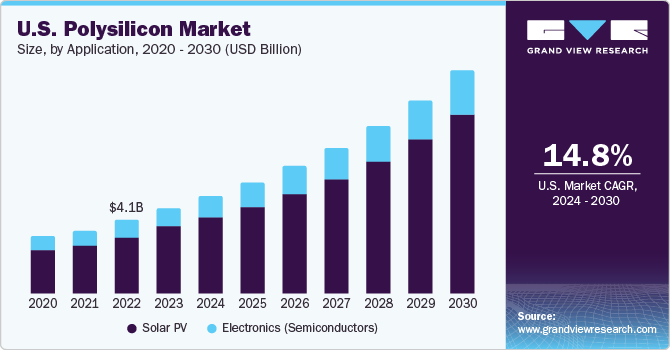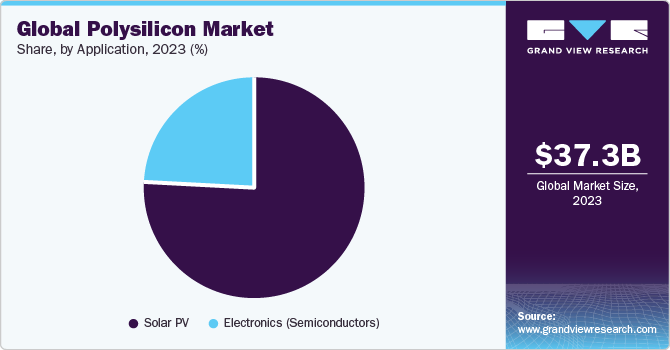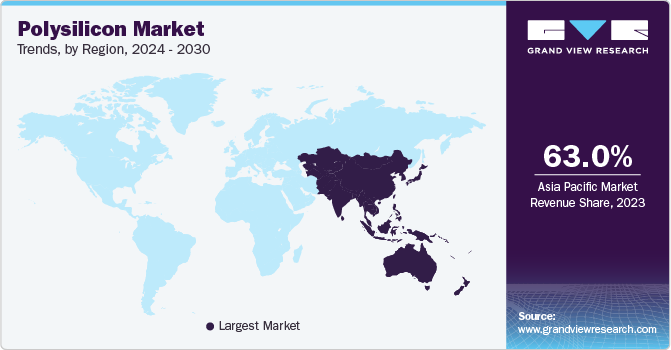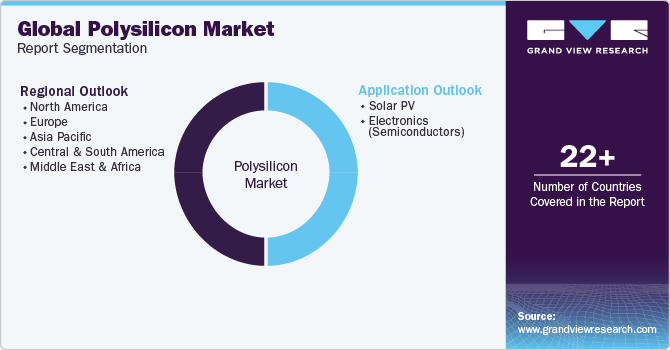- Home
- »
- Plastics, Polymers & Resins
- »
-
Polysilicon Market Size, Share, Growth, Industry Report 2030GVR Report cover
![Polysilicon Market Size, Share & Trends Report]()
Polysilicon Market Size, Share & Trends Analysis Report By Application (Solar PV, Monocrystalline Solar Panel, Multi-crystalline Solar Panel, Electronics), By Region, And Segment Forecasts, 2024 - 2030
- Report ID: GVR-1-68038-340-9
- Number of Report Pages: 109
- Format: PDF, Horizon Databook
- Historical Range: 2018 - 2022
- Forecast Period: 2024 - 2030
- Industry: Bulk Chemicals
Polysilicon Market Size & Trends
The global polysilicon market size was estimated at USD 37.31 billion in 2023 and is expected to grow at a compound annual growth rate (CAGR) of 16.0% from 2024 to 2030. The significant growth of the solar power industry has become a driving force behind the expansion of the market. The increasing adoption of solar energy as a clean and sustainable power source has led to a surge in solar panel production. Moreover, the expansion of electronics and semiconductor industries, driven by the emergence of 5G, IoT, and AI technologies, has driven demand for polysilicon. In addition, government policies and incentives, such as renewable energy targets, subsidies, and tax credits are playing a crucial role in increasing the demand for polysilicon in the solar industry.

The demand for polysilicon in the U.S. is mainly due to its use for manufacturing solar photovoltaic (PV) and semiconductors. The country’s commitment to clean energy sources has stimulated the demand for solar cells and modules, which had a positive impact on the U.S. market. Consistent reliance of the semiconductor industry on high-quality polysilicon for producing semiconductor wafers essential for manufacturing advanced electronic devices, such as smartphones and computers, has created lucrative growth opportunities for the polysilicon sector.
The expanding solar energy industry, favorable government policies and incentives for renewable energy adoption, and the growing importance of polysilicon in advanced electronics and semiconductor industry are crucial factors driving the U.S. polysilicon sector. According to the U.S. Department of Energy (DOE), the U.S. imported 12.2 GWdc of PV modules in Q1 of 2023, a 17% increase compared to the previous quarter. This has positively boosted the demand for polysilicon across the country and is anticipated to follow a similar trend. Investments in R&D, supply chain optimization, and sustainability efforts are expected to play a vital role in triggering the demand for polysilicon.
Application Insights
The solar PV segment dominated the market and accounted for the largest revenue share of more than 76% in 2023. The solar photovoltaic (PV) industry has witnessed remarkable growth in recent years, with polysilicon serving as a fundamental cornerstone of this growing market. Polysilicon, a high-purity form of silicon, is a key material used in manufacturing solar cells, and its availability and cost play a pivotal role in determining the overall economics of solar PV systems.

The growth of solar PV installations, particularly in countries such as China, the U.S., and regions of Europe, has fueled the demand for polysilicon. Manufacturers have responded by increasing their production capacities, driving innovations in polysilicon production processes, and enhancing the purity of the material.
Moreover, efforts to reduce the cost of polysilicon production have been critical in making solar PV more competitive with other energy sources. As solar PV industry evolves, it will likely continue to rely on advances in polysilicon technology to improve efficiency and cost-effectiveness, ensuring that solar energy remains a vital contributor to the transition towards a sustainable and low-carbon energy future.
This market segment's continued growth shows the versatility of polysilicon as a raw material for solar cell manufacturing. Manufacturers have been working to optimize the production of multi-crystalline panels to improve their efficiency and reduce their cost, which, in turn, has spurred innovations in polysilicon production to meet the evolving needs of this segment.
Regional Insights
Asia Pacific dominated the market and accounted for the largest revenue share of over 63% in 2023. The region has experienced significant growth and transformation in recent years. Asia Pacific, particularly China, has emerged as a global powerhouse in the production and consumption of polysilicon, a crucial raw material in the manufacture of solar panels and semiconductors. China's rapid industrialization and urbanization, coupled with its commitment to renewable energy and expansion of its electronics industry, have driven demand for polysilicon to unprecedented levels.

Moreover, the growing solar energy industry, favorable government policies and incentives for renewable energy adoption, and growing importance of polysilicon in advanced electronics and semiconductor industry are crucial factors driving the North American polysilicon industry.
Market Dynamics
The growth of the global electronics industry is a significant driver for polysilicon industry, as it is a crucial raw material for developing semiconductors and other electronic components. As the increasing demand for highly powerful and energy-efficient devices is leading to the continuous evolution of electronics industry, demand for high-quality polysilicon is growing in tandem with it.
Moreover, advancements in solar panel technology have driven the demand for high-quality polysilicon. Presently, manufacturers of solar cells or photovoltaic (PV) cells are continuously striving to improve efficiency and performance of solar cells. Government incentives and policies designed to promote renewable energy adoption have had a deep impact on the growth of the market.
The rising adoption of renewable energy and electric vehicles (EVs), both of which are integral for reducing carbon emissions and promoting sustainability, drives the reliance of electronics industry on polysilicon. Electric vehicles, in particular, increasingly depend on advanced electronics for their performance and efficiency.
Key Companies & Market Share Insights
The market is highly characterized by expansion and joint venture strategies opted by companies globally. Established players such as BASF SE are investing in product development to gain a competitive edge in the market. In June 2023, Wacker Chemie AG announced the expansion of its capacity for semiconductor-grade polysilicon purification. By early 2025, Wacker Chemie AG plans to build a new production line to its Burghausen location, increasing capacity by more than 50%. This strategic investment project is anticipated to require capital expenditures exceeding USD 320.5 million.
Key Polysilicon Companies:
- High-Purity Silicon America Corporation
- OCI COMPANY Ltd.
- Qatar Solar Technologies
- REC Silicon ASA
- Tongwei Group Co., Ltd
- Tokuyama Corporation
- Wacker Chemie AG
- Xinte Energy Co., Ltd
- DAQO NEW ENERGY CO., LTD.
- GCL-TECH
- Hemlock Semiconductor Operations LLC and Hemlock Semiconductor, L.L.C.
Polysilicon Market Report Scope
Report Attribute
Details
Market size value in 2024
USD 42.88 billion
Revenue forecast in 2030
USD 104.69 billion
Growth rate
CAGR of 16.0% from 2024 to 2030
Base year for estimation
2023
Historical data
2018 - 2022
Forecast period
2024 - 2030
Report updated
November 2023
Quantitative units
Volume in units, revenue in USD million/billion, CAGR from 2024 to 2030
Report coverage
Volume forecast, revenue forecast, company ranking, competitive landscape, growth factors, trends
Segments covered
Application, region
Regional Scope
North America; Europe; Asia Pacific; Central & South America; Middle East & Africa
Country scope
U.S.; Canada; Mexico; Germany; UK; Italy; France; Spain; Denmark; Norway; Sweden; China; India; Japan; South Korea; Australia; Brazil; Argentina; South Africa; Saudi Arabia
Key companies profiled
High-Purity Silicon America Corporation; OCI COMPANY Ltd.; Qatar Solar Technologies; REC Silicon ASA; Tongwei Co., Ltd; Tokuyama Corporation; Wacker Chemie AG; Xinte Energy Co., Ltd; DAQO NEW ENERGY CO,.LTD.; GCL-TECH; Hemlock Semiconductor Operations LLC and Hemlock Semiconductor, L.L.C.
Customization scope
Free report customization (equivalent up to 8 analysts’ working days) with purchase. Addition or alteration to country, regional, and segment scope.
Pricing and purchase options
Avail customized purchase options to meet your exact research needs. Explore purchase options
Global Polysilicon Market Report Segmentation
This report forecasts volume and revenue growth at global, regional and country levels and provides an analysis of the latest industry trends in each of the sub-segments from 2018 to 2030. For this study, Grand View Research has segmented the global polysilicon market report based on application, and region:

-
Application Outlook (Volume, Kilotons; Revenue, USD Million, 2018 - 2030)
-
Solar PV
-
Monocrystalline Solar Panel
-
Multicrystalline Solar Panel
-
-
Electronics (Semiconductor)
-
-
Regional Outlook (Volume, Kilotons; Revenue, USD Million, 2018 - 2030)
-
North America
-
U.S.
-
Canada
-
Mexico
-
-
Europe
-
Germany
-
U.K.
-
Italy
-
France
-
Spain
-
Denmark
-
Norway
-
Sweden
-
-
Asia Pacific
-
China
-
India
-
Japan
-
South Korea
-
Australia
-
-
Central & South America
-
Brazil
-
Argentina
-
-
Middle East & Africa
-
South Africa
-
Saudi Arabia
-
-
Frequently Asked Questions About This Report
b. The global polysilicon market size was estimated at USD 37.31 billion in 2023 and is expected to reach USD 42.88 billion in 2024.
b. The global polysilicon market is expected to grow at a compound annual growth rate of 16.0% from 2024 to 2030 to reach USD 104.69 billion by 2030.
b. Solar PV segment dominated the polysilicon market with a share of 76.47% in 2023. This is attributed to the rise in demand for renewable energy sources continues to surge worldwide, the polysilicon market has experienced significant expansion to meet this escalating need.
b. Some key players operating in the polysilicon market include High-Purity Silicon America Corporation; OCI COMPANY Ltd.; Qatar Solar Technologies; REC Silicon ASA; Tongwei Group Co., Ltd; Tokuyama Corporation; Wacker Chemie AG; Xinte Energy Co., Ltd; DAQO NEW ENERGY CO., LTD.; GCL-TECH; and Hemlock Semiconductor Operations LLC and Hemlock Semiconductor, L.L.C.
b. Key factors that are driving the market growth include flourishing solar power industry and growing electronics industry across the globe.
Share this report with your colleague or friend.
![gvr icn]()
NEED A CUSTOM REPORT?
We can customize every report - free of charge - including purchasing stand-alone sections or country-level reports, as well as offer affordable discounts for start-ups & universities. Contact us now
![Certified Icon]()
We are GDPR and CCPA compliant! Your transaction & personal information is safe and secure. For more details, please read our privacy policy.
We are committed towards customer satisfaction, and quality service.
"The quality of research they have done for us has been excellent."





